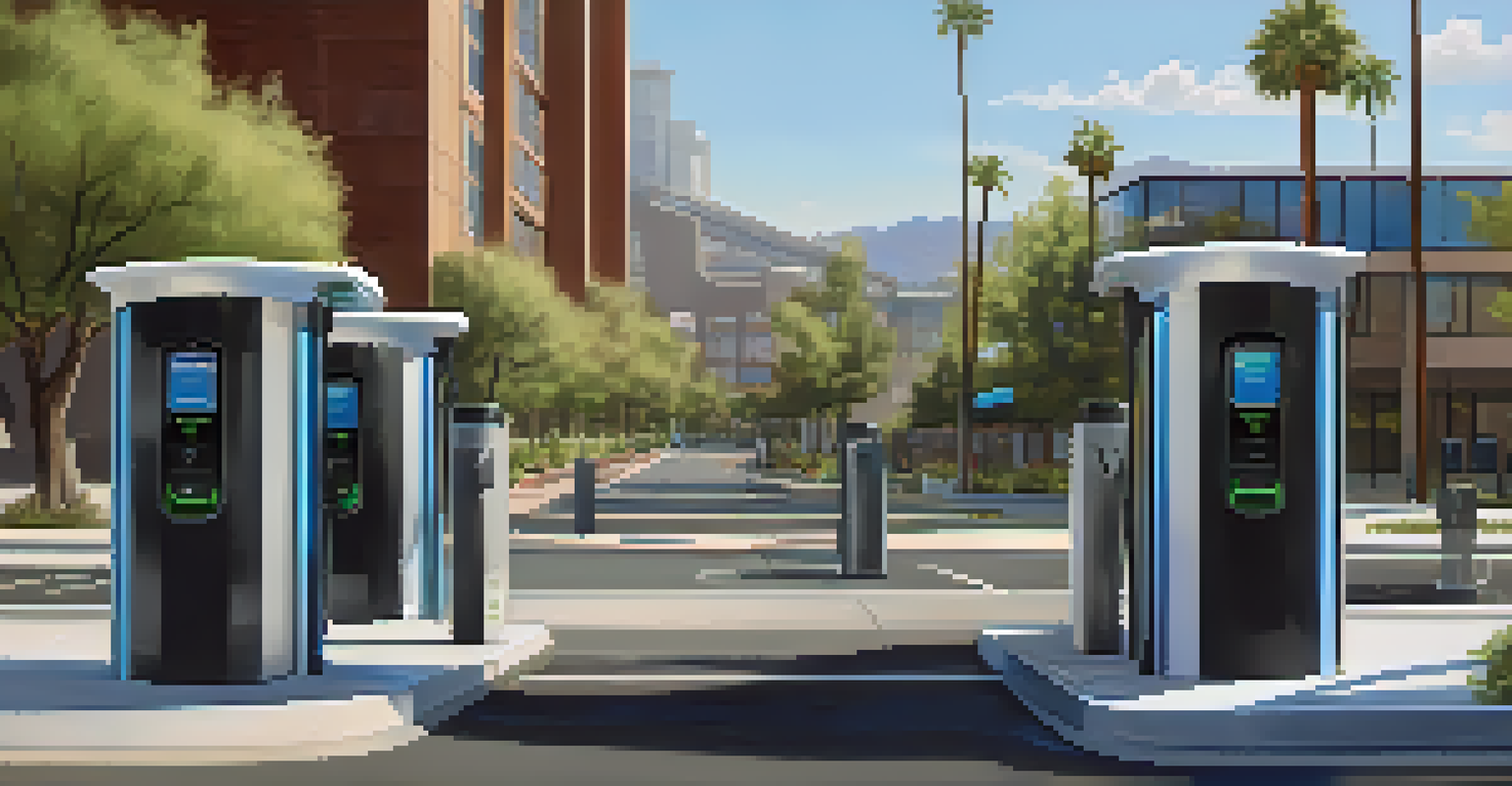Key Milestones in Arizona's Transportation Infrastructure

The Birth of Arizona's Transportation Network
Arizona's transportation infrastructure began taking shape in the early 20th century with the establishment of essential roadways. The construction of the Territorial Road in the 1860s marked a pivotal moment, connecting various settlements and promoting trade. These early roads laid the groundwork for a more extensive network that would support the growing population and economy.
Transportation is the linchpin of our economy and the lifeblood of our communities.
As the state became more populated, the need for reliable transportation grew, leading to the development of highways. The creation of the Arizona Highway Department in 1927 was a significant milestone, as it centralized efforts to improve and maintain roadways across the state. This organization played a crucial role in planning and implementing highway projects that would benefit residents and travelers alike.
By the mid-20th century, Arizona's transportation network expanded dramatically, facilitating commerce and tourism. The establishment of the U.S. Route 66 in 1926, which ran through Arizona, became a symbol of American road adventure. This iconic highway not only boosted local economies but also fostered a culture of travel that remains part of Arizona's identity today.
The Interstate Highway System: A Game Changer
The introduction of the Interstate Highway System in the 1950s marked a transformative period for Arizona's transportation infrastructure. Designed to improve national defense and facilitate commerce, this network allowed for faster and safer travel across states. Arizona's segments of Interstate 10 and Interstate 40 became vital arteries for both local and long-distance traffic.

The construction of these interstates had profound effects on urban development, particularly in cities like Phoenix and Tucson. Increased accessibility attracted businesses and residents, spurring economic growth and urban sprawl. As a result, these highways not only connected cities but also reshaped the landscape of Arizona.
Growth of Arizona's Roads
Arizona's transportation network evolved from early roadways in the 1860s to a comprehensive system supporting commerce and tourism.
However, the expansion of the Interstate system also introduced challenges, such as traffic congestion and environmental concerns. As Arizona's population continued to grow, the state faced the need to adapt its infrastructure to accommodate increasing vehicle numbers. This led to ongoing discussions about sustainable transportation solutions and smart planning.
Public Transportation: A Growing Priority
In recent years, Arizona has shifted its focus towards enhancing public transportation options. As urban areas became more congested, the importance of developing efficient transit systems became clear. The Valley Metro in Phoenix is an excellent example, providing light rail and bus services to accommodate the region's growing population.
The future belongs to those who believe in the beauty of their dreams.
The introduction of the light rail system in 2008 marked a significant milestone in public transit. This transit option not only provides an alternative to driving but also promotes sustainability by reducing emissions and traffic congestion. The light rail has quickly become a popular choice for commuters, demonstrating the community's commitment to diverse transportation options.
Efforts to improve public transportation are ongoing, with plans for expansion and additional routes in the pipeline. As Arizona continues to grow, the integration of public transit into the broader transportation infrastructure is crucial. This shift not only addresses immediate transportation needs but also aligns with the state's long-term sustainability goals.
Innovations in Transportation Technology
As technology advances, Arizona has embraced innovations that enhance transportation efficiency and safety. The introduction of Intelligent Transportation Systems (ITS) has revolutionized how traffic is managed. These systems utilize real-time data to monitor traffic flow, detect incidents, and communicate with drivers, improving overall travel experiences.
Moreover, Arizona has been at the forefront of autonomous vehicle testing, positioning itself as a leader in transportation innovation. Companies like Waymo have conducted extensive testing in Phoenix, exploring the potential of self-driving technology to reshape urban mobility. This initiative not only promises to enhance safety but also aims to reduce traffic congestion.
Public Transit Gains Importance
Recent efforts in Arizona have focused on enhancing public transportation, exemplified by the successful Valley Metro light rail system.
The incorporation of technology into transportation infrastructure reflects Arizona's commitment to creating a modern and efficient network. As these innovations continue to develop, they hold the potential to redefine how residents and visitors navigate the state. The future of transportation in Arizona looks promising, with technology paving the way for smarter solutions.
Sustainability Initiatives in Transportation
Sustainability has become a key focus in Arizona's transportation planning. With growing awareness of environmental issues, the state has initiated programs to promote eco-friendly transportation options. Investments in electric vehicle infrastructure, such as charging stations, are part of a broader strategy to reduce carbon emissions and promote cleaner travel.
Additionally, Arizona has explored alternative modes of transportation, like biking and walking, to create a more sustainable urban landscape. The development of bike lanes and pedestrian-friendly areas encourages residents to opt for non-motorized transportation, leading to healthier communities. These efforts align with a vision for a more interconnected and environmentally responsible transportation network.
Community engagement is crucial in these sustainability initiatives. As residents voice their transportation needs and preferences, planners can create solutions that resonate with the public. This collaborative approach helps ensure that Arizona's transportation infrastructure evolves in a way that balances growth with environmental stewardship.
Funding Challenges and Solutions
Funding remains a critical challenge in maintaining and improving Arizona's transportation infrastructure. With rising costs and limited state and federal funding, finding sustainable solutions has become increasingly important. Budget constraints often lead to difficult decisions about which projects receive funding and which are delayed.
To address these challenges, Arizona has explored various funding models, including public-private partnerships. These collaborations can leverage private investment to support infrastructure projects, offering innovative solutions to budgetary constraints. By sharing the financial burden, the state can accelerate improvements and expand services.
Sustainability in Transportation
Arizona is prioritizing eco-friendly initiatives, including investments in electric vehicle infrastructure and promoting non-motorized transport.
Moreover, community support and advocacy play a vital role in securing funding for transportation projects. Engaging residents in discussions about infrastructure needs can lead to increased awareness and support for funding initiatives. As stakeholders work together, Arizona can build a more robust transportation system that meets the needs of all its residents.
Future Directions for Arizona's Transportation
Looking ahead, Arizona's transportation infrastructure is poised for continued evolution. With a growing population and changing needs, the state is focusing on creating a more integrated and efficient network. This includes investments in multimodal transportation options that cater to diverse travel preferences.
Emerging technologies, such as smart city initiatives, are also shaping the future of transportation. By leveraging data analytics and connectivity, Arizona can enhance traffic management and improve the overall travel experience. This forward-thinking approach aims to create a transportation ecosystem that is responsive to the needs of its users.

Ultimately, the future of Arizona's transportation infrastructure will depend on collaboration among stakeholders, innovation, and a commitment to sustainability. As the state embraces these principles, it can create a transportation system that not only meets current demands but also prepares for future challenges, ensuring a thriving Arizona for generations to come.